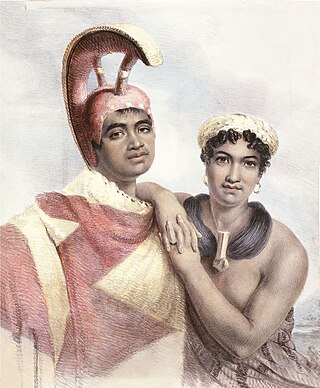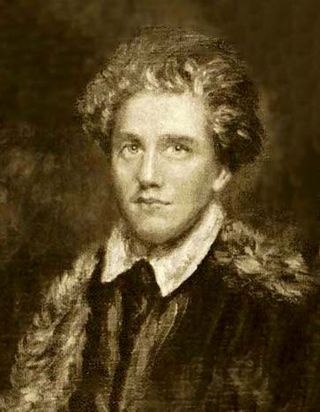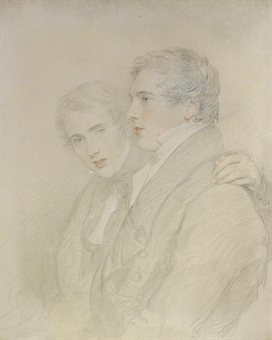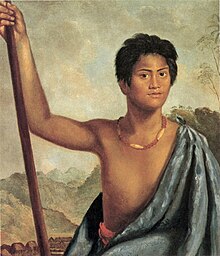Charles Robert Malden, was a nineteenth-century British naval officer, surveyor and educator. He is the discoverer of Malden Island in the central Pacific, which is named in his honour. He also founded Windlesham House School at Brighton, England.

Kamehameha II was the second king of the Kingdom of Hawaii. His birth name was Liholiho and full name was Kalaninui kua Liholiho i ke kapu ʻIolani. It was lengthened to Kalani Kaleiʻaimoku o Kaiwikapu o Laʻamea i Kauikawekiu Ahilapalapa Kealiʻi Kauinamoku o Kahekili Kalaninui i Mamao ʻIolani i Ka Liholiho when he took the throne.

Kuini Liliha was a High Chiefess (aliʻi) and noblewoman who served the Kingdom of Hawaii as royal governor of Oʻahu island. She administered the island from 1829 to 1831 following the death of her husband Boki.

Mānoa is a valley and a residential neighborhood of Honolulu, Hawaiʻi. The neighborhood is approximately three miles (5 km) east and inland from downtown Honolulu and less than a mile from Ala Moana and Waikiki at 21°18.87916′N157°48.4846′W.

Maria Graham, Lady Callcott, was a British writer of travel books and children's books, and also an accomplished illustrator.

Puʻuhonua o Hōnaunau National Historical Park is a United States National Historical Park located on the west coast of the island of Hawaiʻi in the U.S. state of Hawaii. The historical park preserves the site where, up until the early 19th century, Hawaiians who broke a kapu could avoid certain death by fleeing to this place of refuge or puʻuhonua. The offender would be absolved by a priest and freed to leave. Defeated warriors and non-combatants could also find refuge here during times of battle. The grounds just outside the Great Wall that encloses the puʻuhonua were home to several generations of powerful chiefs.

Kealakekua Bay is located on the Kona coast of the island of Hawaiʻi about 12 miles (19 km) south of Kailua-Kona. Settled over a thousand years ago, the surrounding area contains many archeological and historical sites such as religious temples (heiaus) and also includes the spot where the first documented European to reach the Hawaiian islands, Captain James Cook, was killed. It was listed in the National Register of Historic Places listings on the island of Hawaii in 1973 as the Kealakekua Bay Historical District. The bay is a marine life conservation district, a popular destination for kayaking, scuba diving, and snorkeling.
The Mauke starling or mysterious starling is an extinct species of starling found on the island of Mauke, Cook Islands. The binomen is the result of Buller's misreading of the name inornata on the specimen label. As he seems to have genuinely believed this spelling to be correct, the binomial, although it has no meaning, is valid.

Captain Alexander Adams (1780–1871) was a Scotsman who served in the British Royal Navy and then came to the Hawaiian islands and served in the navy of the Kingdom of Hawaii. Known to the Hawaiians as Alika Napunako Adams.
Admiral George Anson Byron, 7th Baron Byron was a British nobleman, naval officer, peer, politician, and the seventh Baron Byron, in 1824 succeeding his cousin the poet George Gordon Byron, 6th Baron Byron in that peerage. As a career naval officer, he was notable for being his predecessor's opposite in temperament and lifestyle.

Robert Dampier (1799–1874) was a British artist and clergyman.

Don Francisco de Paula Marín (1774–1837) was a Spaniard who became influential in the early Kingdom of Hawaii. Often called Manini, Marini or other variations, he became a confidant of Hawaiian King Kamehameha I. Marín acted as a jack-of-all-trades, sometimes even acting as a physician, probably without any formal education, and is credited with introducing many agricultural products.

Boki was a High Chief in the ancient Hawaiian tradition and served the Kingdom of Hawaii as royal governor of the island of Oahu. Boki ran a mercantile and shipping business and encouraged the Hawaiians to gather sandalwood for trade.

Naihe-Kukui Kapihe, known as "Captain Jack" or "Jack the Pilot" to visitors, served as Honolulu harbor master and admiral of the royal fleet in the early Kingdom of Hawaii. His daughter would become a Queen consort.

The Waiākea Mission Station was the first Christian mission on the eastern side of the Island of Hawaiʻi. Also known as the Hilo Station, the latest structure is now called Haili Church.

High Chiefess Kapiʻolani was an important member of the Hawaiian nobility at the time of the founding of the Kingdom of Hawaiʻi and the arrival of Christian missionaries. One of the first Hawaiians to read and write, as well as sponsoring a church. She made a dramatic display of her new faith, which was the subject of a poem by Alfred, Lord Tennyson.

Naihe was the chief orator and councilor during the founding of the Kingdom of Hawaii. A champion athlete in his youth, he negotiated for peace at several critical times and helped preserve the remains of several ancient leaders.

Andrew Bloxam was an English clergyman and naturalist; in his later life he had a particular interest in botany. He was the naturalist on board HMS Blonde during its voyage around South America and the Pacific in 1824–26, where he collected mainly birds. Later as a Church of England minister he lived in Warwickshire and Leicestershire and made significant contributions to the study of the natural history of the area. His special interest was in fungi and the genera Rubus and Rosa. His botanical author abbreviation is "A.Bloxam".
L'Aigle was launched in France in 1801, 1802, or 1803. The British Royal Navy captured her in 1809. From 1810 to 1817, she was a West Indiaman. From 1817 L'Aigle made four complete voyages as a whaler in the British Southern Whale fishery. On her third whaling voyage, she carried King Kamehameha II of Hawaii and Queen Kamāmalu with a number of their retainers and Hawaiian notables to England. She was lost on 6 March 1830 on her fifth whaling voyage.
James Macrae was a Scottish botanist.

















